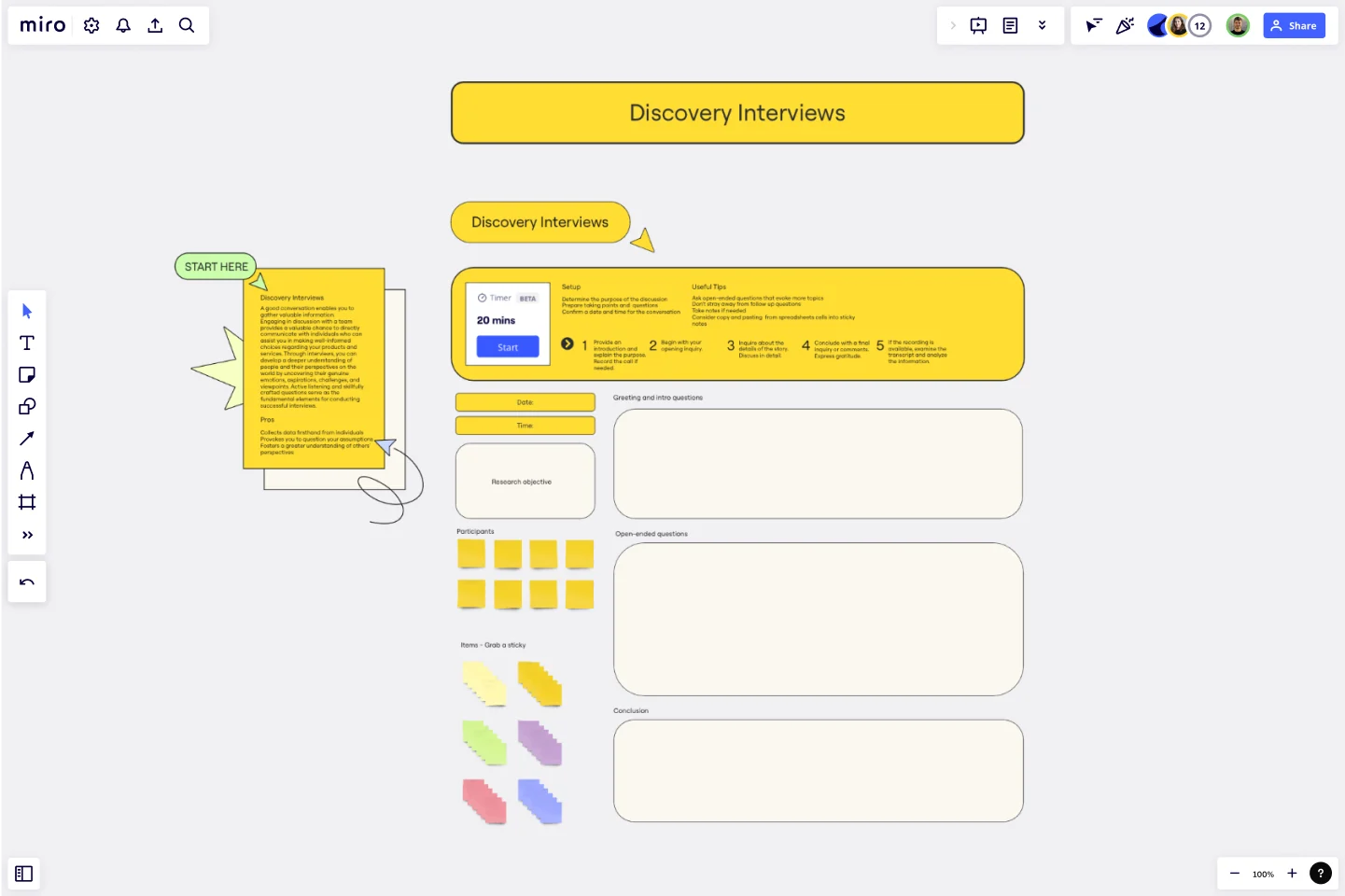Discovery Interviews Template
Gather valuable information and understand different perspectives with the Discovery Interviews Template
About Discovery Interviews Template
The Discovery Interview Template allows you to gather valuable information, helping you directly communicate with individuals who can assist you in making well-informed choices regarding your products and services.
Through interviews, you can develop a deeper understanding of people and their perspectives on the world by uncovering their genuine emotions, aspirations, challenges, and viewpoints. Active listening and skillfully crafted questions are fundamental elements for conducting successful interviews.
Benefits of using the Discovery Interviews Template
Collects data firsthand from individuals.
It provokes you to question your assumptions.
Fosters a greater understanding of others' perspectives.
How to use the template in Miro
Provide an introduction, explain the purpose, and record the call if needed.
Begin with your opening inquiry.
Inquire about the details of the story. Discuss in detail.
Conclude with a final inquiry or comments. Express gratitude.
If the recording is available, examine the transcript and analyze the information.
Setup
Determine the purpose of the discussion.
Prepare talking points and questions.
Confirm a date and time for the conversation.
Useful tips
Ask open-ended questions that evoke more topics.
Don't stray away from follow-up questions.
Take notes if needed.
Consider copying and pasting from spreadsheet cells into sticky notes.
Double-click containers and elements to edit to suit your needs.
Get started with this template right now.
Service Blueprinting Workshop
Works best for:
Agile
The Service Blueprinting Workshop template helps teams visualize and improve service processes. It includes ice breakers, context canvas, empathy maps, and action plans for service transitions. Use it to align teams, identify opportunities, and prototype service delivery from a macro to microscopic level, ensuring a comprehensive understanding of service orchestration and seamless collaboration. Ideal for remote and dispersed teams.
Storyboarding Template
The Storyboarding Template is an excellent way to visualize how people will experience your concept in action. It primarily consists of images, which enable teams to communicate ideas with greater clarity and emotional impact than words alone. You don't need exceptional artistic skill to create storyboards; you simply need to depict a meaningful sequence of events.
Empathy Mapping by ServiceNow
Works best for:
Research & Design, Market Research
The Empathy Mapping template helps teams capture detailed user insights. By understanding user perspectives, you can improve product features and customer satisfaction. This template is perfect for user research and product development.
Proto Persona Template
Works best for:
UX, UX Research, Product Design
The Proto Persona Template is tailored to capture the essence of hypothetical user segments. It encapsulates key attributes such as user needs, behaviors, and potential pain points. One of its standout benefits is its ability to foster empathy. By visualizing and understanding these preliminary user profiles, design and strategy teams can tap into a deeper connection with their target audience, ensuring that solutions resonate authentically and address genuine needs.
Heuristic Evaluation Template
Works best for:
Design
The Heuristic Evaluation Template is a valuable tool in UX design. It relies on heuristics to identify usability issues and opportunities for improvement. Similarly, design heuristics serve as guidelines to evaluate the quality of a design solution. Following ten principles of good design can enhance the effectiveness of a product or service. Use these guidelines to evaluate your work and enhance the user experience of your design solutions.
Empathy Map by Back of the Napkin Consulting
Works best for:
Research & Design, Market Research
The Empathy Map template is designed to help you understand your users deeply. It captures user behaviors, thoughts, and feelings, allowing you to design products that truly resonate with their needs. Use this template to enhance your UX research and create user-centered designs.
